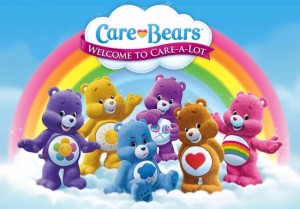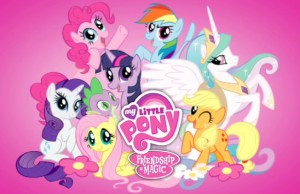The cult-popularity of My Little Pony: Friendship is Magic may have its supporters and detractors, but the show itself is sweet and engaging in itself, and that can’t be denied, thanks to the talented writers and animators behind the show. One of the writers, Amy Rogers Keating, was willing to talk to be about MLP as well as Care Bears: Welcome to Care-A-Lot, where she is currently story editor. Be sure to follow her Twitter account here, as well as her Youtube page and the trailer to her documentary “Jason Bateman Think’s I’m Dead”.
Amy will also be at Midwestria, Septemeber 14-16, in Illinois.
TMB: Contrary to most interviews, I’d actually like to start off with Care Bears. You had a varied career in a lot of hand-drawn animation, so is it difficult to slow the “energy” down for a CGI cartoon?
AKR: Hmmm…I’m not sure what you mean by “slow the energy down.” Writing for any kind of animation is the same for me whether it’s hand-drawn, flash, or CGI. However, the writing does differ depending on the audience that it’s being written for. For instance, a preschool show is different than a show for a 6 to 9 year old audience because you have to explain more. With Care Bears and MLP, I know that the audience will grasp ideas without having to repeat or really spell them out.
TMB: I wanted to clarify that “slow down the energy” question. I meant in terms of wackier, more physical-based gags that may stretch character or cartoon physics. For example, in something like “Feeling Pinkie Keen,” Twilight is put through the ringer when trying to find the secret to Pinkie’s “Pinkie Sense.” I don’t imagine that it be as feasible to pile on so many physical gags like that in Care Bears, or most CGI cartoons. I guess my real question was if you had to limit those types of gags and behaviors, and if the change of pace was easier or harder.
AKR: Okay! Now I understand!
I guess I really didn’t think about having to limit myself as far as the cartoon physics because those issues never really came up in the stories. Not that we don’t have plenty of goofy gags and silliness, just not specifically what you’re talking about. Of course, the storyboard artists and animators know better what can be pushed in CGI and can put that humor in when the scripts get to those stages. I’m always amazed at what they pull off!
TMB: How did you decide which of the Care Bears to use as the core group?
AKR: I actually wasn’t part of that decision. When I was brought on as Story Editor, the core Care Bears had already been chosen. The great thing is that with so many Care Bears in the universe, we’re able to have lots of fun cameos!
TMB: Grumpy always was an interesting character to me, regardless of iteration. He seems to be, to put it as best I can, the writers’ way of expressing a certain self-loathing (in the most kid-friendly way possible) of working on a show about overly-friendly bears. Am I in the ball park, or am I way off here?
AKR: Grumpy is great! And once Doug Erholtz started doing his voice, it got even more fun because we saw how far we could push Grumpy and knew that Doug would enhance it even more!
But I fear you are “way off” regarding the whole self-loathing thing. I really love writing for shows that take place in worlds like Care-a-Lot and Equestria. These worlds are full of joy and silliness and songs. Not a bad place to hang out during your work day! As for the Care Bears being “overly-friendly,” I think that is looking at them too simply and too much on the surface. They are much more well-rounded than that. Yes, they are all Care Bears at the core (even Grumpy cares!), but they all have their flaws which make them very interesting and fun to write for. Share has jealousy issues, Harmony can be a bit bossy, and Funshine can be inconsiderate, forgetting that others need to have fun too. In Season One we really got to explore their personalities discovering what made each Care Bear tick.
TMB: Any chance we’ll be seeing the Care Bear Cousins?
AKR: The Care Bear Cousins won’t be appearing in Season One. But who knows about the future?
TMB: Okay, now I’ll ask about My Little Pony. It’s certainly a looser, wackier cartoon than most people expected. Did Lauren Faust and company come to the property with that vibe in mind, or did it develop organically over the course of production?
AKR: Lauren created the show with that vibe in mind. She wanted a fun, non-dumbed down show for girls. Her shorter draft of Ticketmaster had all of that silliness in there. Now, this was certainly built upon by the rest of the production team. But Lauren guided it all and knew what she was going for.
TMB: The explosion of cult popularity behind the show must have been unexpected. How have you been managing so far?
AKR: It is unexpected, though I had experienced a smaller version of this back on Powerpuff Girls. So, when I found out that adults–mainly men–were enjoying MLP: FiM, I wasn’t that shocked.
I’m managing the fandom well. I went to BronyCon and met a lot of fans and everyone was incredibly kind and appreciative. It was fantastic to experience their love for the show first hand. Bronies would break into song, which I found so amazing!
TMB: Although some fans can be overwrought, you have to be proud to produce something that even grown men will admit they enjoy. How do you think this idea proliferated? Do you think this may be the beginning of a change of view about how animation is perceived?
AKR: I am absolutely proud to be part of MLP:FiM. But then, I was proud of it before the show exploded with popularity. When it premiered, I was telling all the moms I know with daughters about this great new version of My Little Pony and was really excited that these girls had such a great show to watch with such strong female characters.
As for how the show proliferated to the adult male fan base, I think these viewers are animation fans to begin with. Since Lauren’s name was attached to the show and she has such a great track record, I’m sure they tuned in just to see what her latest show was. Then, when they saw the awesome designs, the great animation, the compelling characters, the fantastic music, and the strong writing, they got hooked!
I think animation has been gaining more respect for quite awhile. However, the fact that a children’s show is getting this kind of recognition is more unusual, but great!
TMB: Favorite character? How about favorite episode?
AKR: I really love Pinkie Pie. She is so silly and quirky and random. She’s very fun to write for because I can just go to my goofball side.
I enjoyed “A Friend in Deed” a lot because it was a full-on Pinkie episode. Plus there was one big song and lots of little ones and I love getting to write music.
TMB: Is maintaining continuity a main concern for the show? I understand the need for every episode to stand on its own, but how much emphasis is placed on making sure that events and ideas from earlier episodes continue in later episodes?
AKR: In Seasons One and Two, while the show isn’t serialized, we definitely were aware of keeping things consistent as the episodes were written, building upon the world and developing the characters as we went. I read everyone else’s scripts to make sure I knew about any changes and progress.
TMB: What’s next for the Spike and the Main 6?
AKR: Gosh, I have no idea! Because I was busy story editing on Care Bears, I did not write for Season 3. I’m looking forward to watching along with all the Bronies!



